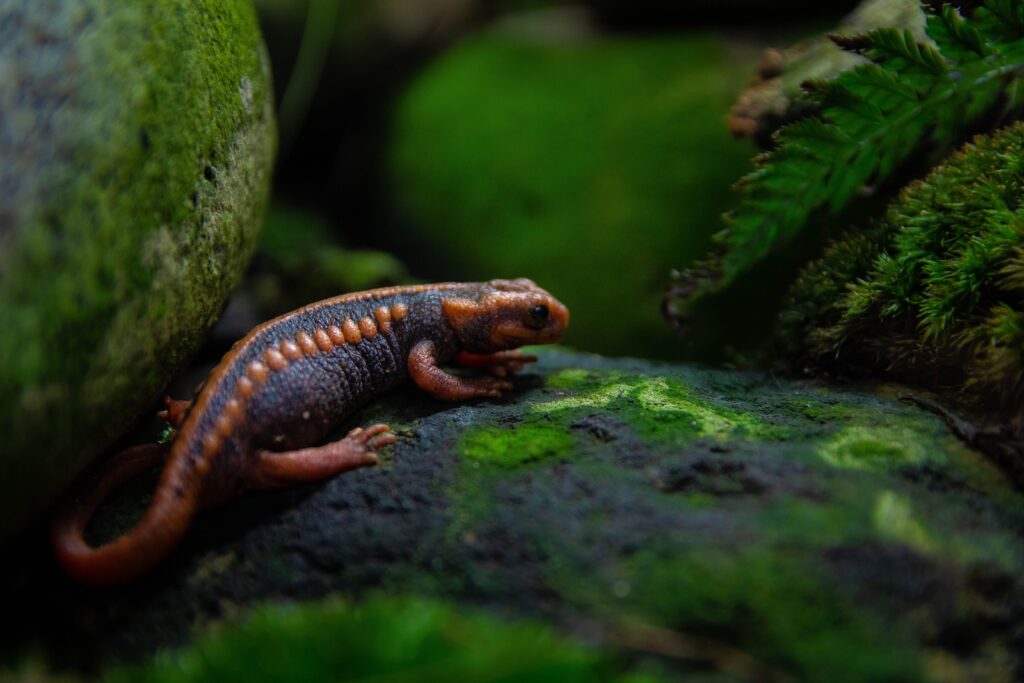I have always loved salamanders. Growing up in the Blue Ridge Mountains, every spring my mom would take my brother and I out on “salamander hunts.” Armed with rainboots and an identification guide, we would head through the woods and down to the stream. There, we would keep our eyes peeled for any of these creatures. Once we saw one, we would scramble through the book, trying to figure out what it was. Unfortunately, salamanders and other amphibians are some of the world’s most endangered vertebrates. Due to habitat loss, waterway pollution, and loss of food sources, these creatures are becoming increasingly rare. However, they are amazing animals who feature prominently in mythology and play an important role in many ecosystems.

What Are Salamanders?
Salamanders are amphibians that closely resemble lizards. They are covered in smooth, moist skin like other amphibians. Incredibly, many species do not have lungs. Instead they may breathe through their skin. This adaptation makes them especially vulnerable to pollution and toxins. Salamanders vary in size, but most are only a few inches long.
Like many amphibians, salamanders spend the first part of their lives as aquatic creatures. Some species, like the beloved axolotl, spend their whole lives in the water. Generally however, adults will become terrestrial. Female salamanders lay their eggs in pools of water. When the young hatch, they have gills enabling them to breathe underwater. However, eventually the young lose these gills and make their way to land. Salamanders will never venture too far from the water though, as they need to stay moist at all times.
What’s the Difference Between a Newt and a Salamander?
Newts are simply a type of salamander. They begin their lives in the water, then move to land for a teenage stage. During this teenage time they are known as efts. Unlike other salamanders, newts actually develop lungs, which they use to breathe. Once they reach adulthood, newts return to the water where they live an aquatic or semi-aquatic life.
Salamanders in Mythology
Salamanders play an interesting role in myths and legends. Oddly enough, these moisture loving creatures are often associated with fire in European mythological traditions. The word salamander is actually derived from Ancient Greek for “fire lizard.” This strange association may be due to the brightly colored markings many species display. However, ancient occultists parlayed this association into a belief that salamanders are born of fire and can pass through flames unharmed. These creatures’ elusive nature may have also contributed to the air of mystery and other-worldliness which was ascribed to them.
Why are Salamanders Important For the Environment?
Salamanders play a crucial role in their environments. For one thing, they eat insects which makes them good for pest control. They also are food for larger animals. This makes them vital to food webs.
Salamanders also play an important role in woodland’s carbon cycles. Because of their diet, which consists of insects who shred leaves to eat them, salamanders help prevent carbon from being released into the air. This is because the leaves of deciduous trees produce leaf litter which is almost half carbon. When insects shred these leaves to eat them, that carbon is released into the atmosphere. However, when salamanders consume these insects the leaves become trapped under another layer of leaves which allows the carbon to be absorbed into the soil and sequestered. Pretty wild, huh?
Additionally, these shy, slimy creatures are an indicator species. Because of their breathable skin, they are especially susceptible to pollution and toxins. This means that salamanders will often disappear before other creatures, indicating that something is wrong.
What Threats are Salamanders Facing?
Sadly, salamanders and other amphibians are facing severe threats. Habitat loss due to human population spread affects these creatures in two ways. Not only does it remove important habitat, but it also fragments the remaining habitat. This makes the salamander population in the remaining habitat particularly vulnerable to secondary threats. Since many salamander species already live in specific, high-elevation habitats, this is of particular concern.
The chytrid fungus has also emerged as a new threat. This fungus is believed to have emerged due to the pet trade. It has already destroyed European salamander populations. Unfortunately, it may soon do the same in the United States if it is not controlled.
Like many other animals, climate change also plays a significant role in the loss of salamander populations. These creatures have evolved to specific conditions. Additionally, they require constant moisture. Global warming, pollution, and biodiversity loss are all taking their toll on salamander populations.
How Can We Help?
There are a few things we can do to protect salamanders and other amphibians. First, lend your voice to these amazing creatures. Educate others on their plight and support legislation to protect and establish natural areas. Additionally, keep as much of your yard or garden in a natural state as possible. Leaving your yard or garden in a natural state includes avoiding removing rotting logs. Logs provide habitat and hunting grounds to salamanders.
Another way to help salamanders is to avoid the use of fertilizers and pesticides. These can pollute waterways and prove deadly to salamanders and their delicate skin. In the same vein, avoid disrupting streams by moving rocks or damming them. Lastly, remember if you see a salamander, do not pick it up or touch it. Salamander’s delicate skin can be damaged by the oil, salt, and products on our hands. Instead, give them a wave and admire them from afar!
Get more like this—Sign up for our daily inspirational newsletter for exclusive content!
__
Photo: Etienne Assenheimer via Unsplash




